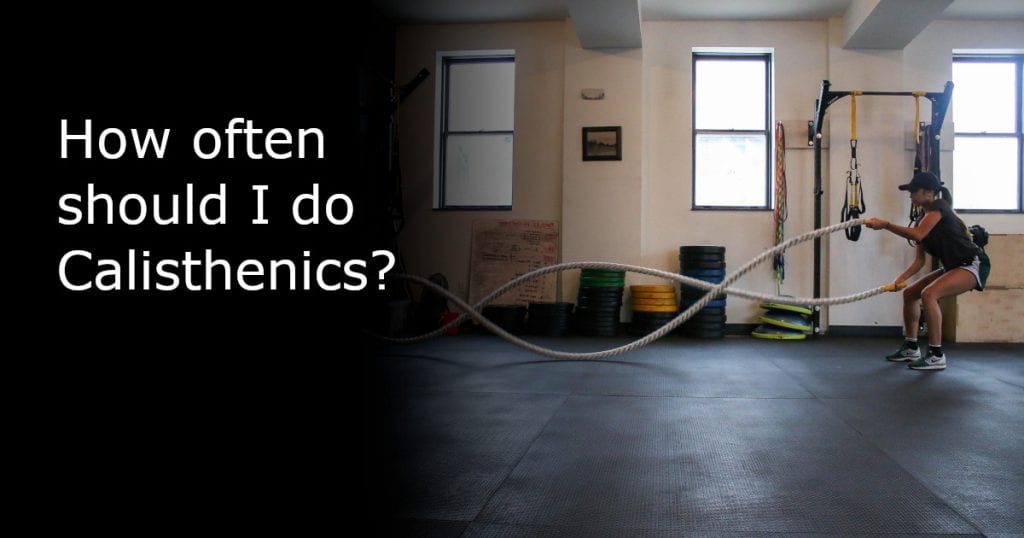Gym outfit? Check. Protein shake? Check. A complete list of exercise routines to try out? Check.
From your workout plan to your training gear, we’re sure that you want everything to be laid out perfectly as you commit to calisthenics. Anything to get your dream body, right? However, there’s one big question that you gotta answer if you want to make actual progress – how often should you do calisthenics?
One blog could’ve told you that it’s cool to exercise every day, but your buff buddy said it’s a must give your muscles a break.
We’re here to set things straight with a piece of simple advice – don’t listen to anyone other than your own body! Count on this guide to help you determine the best calisthenics frequency that’s fit for your personal goals and bodily attributes.
Contents
Factors to consider in deciding how often you should do calisthenics
1. Your Goal

Before you get started, you have to determine whether you want to perform calisthenics as weight training or for aerobics. Your choice will set the intensity of workout sessions you need along with the recovery time required in between them.
If you want calisthenics to help build your muscle strength and endurance, your workout can only do its job if you allow yourself to rest. Take it from the experts of Harvard Health Publishing who recommend that your body needs a break of at least 48 hours between bodybuilding sessions. Perhaps even more if you’re still sore as hell.
So if you’ve been pushing your limits with high-intensity weight exercises, the Department of Health and Human Services (HHS) finds it ideal if you do calisthenics for all your major muscle groups at least twice a week.
Meanwhile, going for aerobics will involve less intense exercises that will not fatigue your muscles as much as bodybuilding would. Without making yourself drop dead, you can enjoy stronger cardiovascular health and a more reliable immune system.
Ideally, it will be possible to do this type of calisthenics every day. HHS advises though that you should take at least one day off to make sure you’re not overdoing it. At least 75 minutes of vigorous-intensity exercises and 150 minutes of moderate-intensity workouts should be enough for each week. Feel free to double that if your body can handle it!
2. Your Heart Rate

It’s easy to say “I’m gonna get ripped and sweat ‘til I drop,” but your fitness goals must consider your cardiovascular health too. If you want an objective, quantifiable metric to determine how often and intense your calisthenics sessions should be, you’ll have to monitor your heart rate.
Let’s first find out what your maximum heart rate is. It’s pretty easy – just subtract your age from 220. So if you’re 30 years old, the average number of heartbeats you have per minute must not exceed 190. This will then be your guide in determining your target heart rate zone, the optimum level to get results without being overworked.
It’s best for people with low heart rate limits to reduce their calisthenics frequency. But if your cardiovascular health is in top shape, you’re good to go for intense weight training sessions.
3. How Your Body Responds to Exercise

Envy of that guy who could easily drop a hundred pushups, but you can’t even get to fifteen without shaking like crazy? Hold yourself together and understand that you simply have different perceived exertion levels. Simply put, this is how your body feels and responds to a certain intensity of exercise.
To know if you’re generally fit enough to push through with your workout goal, consider this guide on the normal bodily responses to calisthenics sessions:
Moderate intensity with aerobics:
- Quickened breathing, but it shouldn’t leave you out of breath
- Light sweating after about 10 minutes of exercise
- It will be hard to sing while working out, but you can still chat with other people
High intensity with bodybuilding:
- Deep and rapid breathing
- Light sweating just after a few minutes
- Talking is impossible without catching your breath
Beware of red flags! If you’re in pain and more fatigued than you intended, it’s probably a sign to lower down your calisthenics intensity and frequency.
4. Your History of Training

Your past experience will also help you assess if you can handle the calisthenics frequency you have in mind. If you’ve barely lifted a muscle before and had a really sedentary lifestyle, it will be torture to force your body to work out every day nonstop. Remember that you have to adapt to your routine physically and mentally so you won’t end up quitting halfway.
This is especially true if you opted to do calisthenics for bodybuilding. As a beginner, it’s best to stick with the minimum frequency of two days and start with basic exercises. Meanwhile, it shouldn’t be so hard to up your game at the onset if you went for aerobics. Even without knowing it, you’ve already been doing low to moderate-intensity calisthenics every day like walking and standing.
Importance of recovery and nutrition in between calisthenics routines
We can’t stress this enough – rest is not your enemy! After you work out, your body is beaten up and exhausted, in technical terms, you have depleted your energy stores and are in need of repair. Even if you don’t feel tired, this could just be your brain tricking you and using a coping mechanism to subdue the stress you’ve put your muscles through. Its best to respect your personal limits and drop on the bed just as much as you hit the gym.

We know you badly want to improve, or perhaps you’re rushing to reach a body goal for an event. But it pays to take note of the following reasons why adequate recovery and nutrition is a must in between your calisthenics routines:
- Let’s break a myth, shall we? It’s not true that you will lose muscle mass and strength if you rest. Actually, strength development will only occur during your recovery period as your body enters into an adaptation process. So long as you match your diet with your energy requirements, you don’t have to worry about losing your progress.
- By introducing a structured rest to your calisthenics routine, you give your muscular and neural systems enough time to recover and adapt to all that stress from working out. This physiological response called “supercompensation” builds up your strength and endurance in the long run.
- Resting prevents you from an unhealthy addiction to training which can badly damage your physical and psychological well being. Recovery periods allow you to regain a balanced perspective.
- One final item, nutrition and proper sleep are key. If you don’t fuel appropriately and you don’t live by your natural circadian pattern, all of the working out, rest, recovery will be for naught!
Warning signs of overtraining
If you think going beyond your limits is a freeway to your ideal body, you’re terribly mistaken. Did you know that excessive exercise can sabotage your physical and emotional health? Rather than make those muscles pop and turn that belly flat pronto, you put yourself at risk to hormonal changes, appetite suppression, wrecked immune system, overworked cardiovascular system, and compromised musculoskeletal health.
To make sure that you aren’t overtraining, learn these warning signs by heart, and listen to your body carefully:
- Stagnated performance – lack of improvement despite increased calisthenics frequency and intensity; decreased strength, agility, endurance, and slow reaction times
- Higher perceived exertion – effortless exercises can seem so frustratingly difficult; all-time high heart rate during and even after working out
- Unbearable fatigue – the inability of your body to recover from previous calisthenics sessions
- Moody behavior – higher cortisol and epinephrine levels that result in irritability, mood swings, and inability to focus
- Insomnia – stress hormones give you a hard time in sleeping, thus preventing your body to repair itself and rest; there are times that even if you get to sleep, you wake up as tired as you were before
- Appetite loss – compromised hunger and satiety mechanisms; ideally, working out should increase your appetite, but the undue psychological exhaustion suppresses it instead
- Recurring and persistent injuries – pain does not go away even after two weeks or so; muscles and joints constantly ache with the slightest movement; higher vulnerability to infections and illnesses due to compromised immune system
- Imbalanced metabolism – constantly low energy levels lead to anemia and other nutrient deficiencies; increased risk to cardiovascular, endocrine, reproductive, nervous, and gastrointestinal complications
- Psychological stress – addiction to working out and bodily pain can cause withdrawals, psychologically prohibiting you from wanting to rest
If you notice any of these red flags, immediately seek professional help and back down from your current frequency and intensity levels of exercise.
Tips for making it possible to do calisthenics every day

When it comes to getting results, consistency is more important than volume. No wonder a lot of people are eager to do calisthenics every day! But as we’ve emphasized a bazillion times, your eagerness to work out should be balanced with the awareness that you also gotta recover.
Let’s talk explore how you could make it possible to do calisthenics every day without burning out:
- Create a structured plan to increase your daily focus while training – Determine what you want to achieve and identify the steps on how to get there. Suppose you wanna learn how to do a handstand. Hours after hours of trial and error will do you no good! Instead, focus first on basic exercises that will condition the strength of your arms, core, and legs.
- Split up and vary your workout routine – Don’t even try to do all exercises in the world in one session. Create a plan that considers the types of workout and the time you’ll need to perform each one, then strategically add variety to your daily training. Check out this sample program:
- Monday: Chest + Triceps
- Tuesday: Biceps + Back
- Wednesday: Legs + Shoulders
- Thursday: Rest day
- Friday: Chest + Triceps
- Saturday: Biceps + Back
- Sunday: Legs + Shoulders
- Autoregulation – Pay attention to the variables affecting your drive to work out, and adapt to them. Breakaway from the myth of “mind over body”! Your physical and emotional state are valid considerations for adjusting your daily training sessions. Otherwise, you might lose every ounce of motivation in you after repeatedly forcing yourself into routines that you aren’t in the mood for.
The bottom line
Forget what worked for your fitness idol, and listen to your own body to achieve your goals and gains. How often you train calisthenics and at what intensity is going to vary according to your own personal goals and capabilities. What can be heaven-sent for other people can be a living nightmare for you!
Before jumping into a calisthenics program, take your time in laying down the type and intensity level of exercises you want and crosscheck it with your overall physical and psychological capacity. Throw in a strategic recovery period and nutritional plan into the mix, and you should get that dream body in no time.



